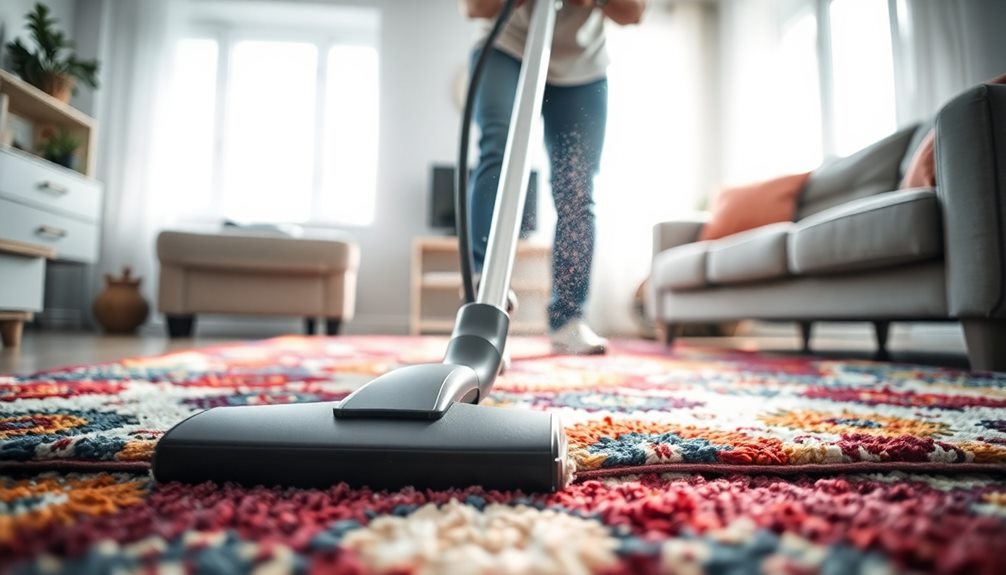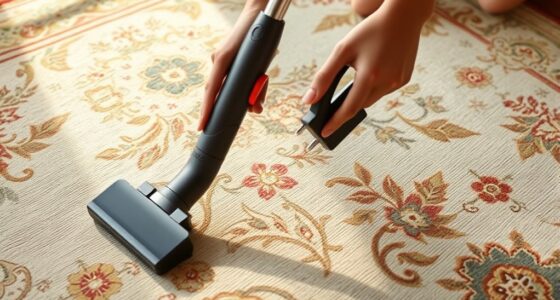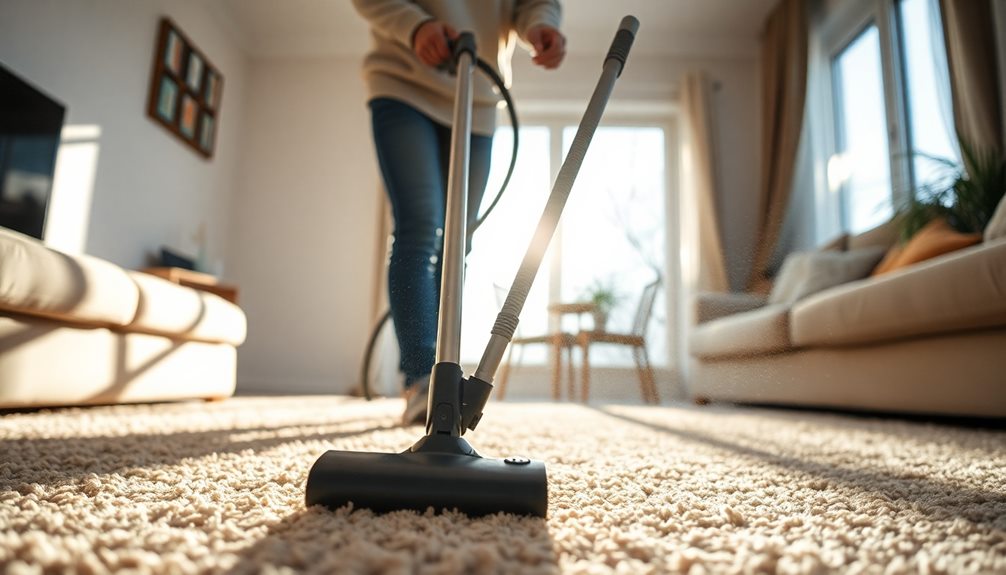To use a vacuum cleaner effectively, start by dusting furniture and clearing your area of small items. Prepare your vacuum by checking the bag or dust container and ensuring attachments are in good shape. Adjust the height setting based on your floor type, using a brush for carpets and a flat nozzle for tight spots. Vacuum slowly, following straight lines and overlapping paths for maximum dirt absorption. Pay special attention to corners and edges, where dust tends to accumulate. Finally, remember to empty the dust container after each use for peak performance. There's more you can learn about vacuuming techniques!
Key Takeaways
- Start by dusting furniture and clearing the area to ensure effective vacuuming without obstacles.
- Prepare the vacuum by checking the bag or container, filters, and attachments for optimal performance.
- Adjust the vacuum settings and height based on the flooring type for better suction and cleaning efficiency.
- Move the vacuum slowly in systematic patterns, focusing on high-traffic areas for thorough dirt absorption.
- Complete the process by emptying the dust container, cleaning filters, and storing the vacuum properly.
Steps to Properly Use a Vacuum Cleaner

To effectively use a vacuum cleaner, start by dusting your furniture and clearing the area of any obstacles. This step enhances your vacuuming efficiency and makes it easier to reach all surfaces.
Additionally, consider how using a vacuum specifically designed for best dust removal can greatly improve your cleaning results.
Next, prepare your vacuum cleaner by checking the vacuum bag or bin capacity. If it's full, empty it to guarantee ideal suction. Also, clean the filters and inspect the vacuum for any damage to cords or attachments.
Once everything's in order, adjust the vacuum settings according to the surface type. Use brush rolls for carpets and flat nozzles for corners.
When you begin using the vacuum cleaner, remember to vacuum slowly. Move back and forth in a steady rhythm, allowing the vacuum time to absorb dirt effectively. Don't forget to revisit high-traffic spots where dirt tends to accumulate.
After you've finished vacuuming, be sure to empty the dust container and clean the filters again.
Proper storage is essential, too—store the vacuum and its attachments in a dry place. Following these steps will help maintain your vacuum's longevity and performance, guaranteeing it's always ready for the next cleaning session.
Dust Furniture and Clear Area

Before you start vacuuming, it's important to dust your furniture and clear the area. Begin by dusting all surfaces, like shelves and tables, to dislodge particles that might fall to the floor during vacuuming. This is particularly important in high-traffic areas where dust can accumulate quickly, impacting your home's air quality.
Don't forget decorative items, as they often collect dust too. This step helps reduce the amount of debris your vacuum's dust filters will need to capture later. For more tips on maintaining cleanliness, consider checking out home remedies for cleaning.
Next, remove movable furniture, such as chairs and coffee tables. This creates an unobstructed pathway for your vacuum cleaner, allowing you to clean efficiently without having to maneuver around obstacles.
It's also vital to clear the area of smaller items, including toys and electronics, which can become tripping hazards and interrupt your cleaning process.
Pay special attention to high-touch areas, like light fixtures and baseboards, since dust accumulates quickly in these spots and can affect your home's air quality.
Organizing your cleaning space not only improves vacuuming effectiveness but also creates a more pleasant and efficient environment for you to work in. By taking these steps, you'll guarantee a thorough cleaning experience and maximize your vacuum's performance.
Prepare the Vacuum Cleaner

A well-prepared vacuum cleaner is important for achieving the best cleaning results. Start by checking the vacuum bag or dust container. If it's 50-75% full, empty it to maintain ideal suction.
Regular maintenance, such as confirming your vacuum cleaner is equipped with HEPA filters, can also greatly enhance its performance. Next, inspect the filters regularly. If they're dirty or clogged, replace them to enhance suction power and overall performance. Dirty filters can greatly reduce your vacuum's effectiveness.
Don't forget to examine the power cord and attachments for any signs of wear or damage. This step is essential for confirming safe operation and preventing electrical hazards while you clean.
Now, familiarize yourself with your vacuum's features and attachments. Using the correct nozzle or brush can make a big difference in tackling various spaces and surfaces.
For example, switching between modes is critical when cleaning carpets and hard floors; confirm you adjust the settings accordingly for maximum effectiveness.
Adjust Settings and Attachments

To get the best results from your vacuum cleaner, you need to adjust the height settings based on your flooring type and select the right attachments for different tasks.
For instance, use the brush roll for carpets and flat nozzles for tight spaces.
Familiarizing yourself with specialized cleaning modes can also boost your vacuum's efficiency.
Cleaning Mode Selection
Selecting the right cleaning mode on your vacuum cleaner is vital for achieving ideal results.
Begin by evaluating the type of surface you're cleaning—carpet, hardwood, or upholstery. Each surface requires a different cleaning mode to optimize performance and guarantee a thorough clean.
Next, familiarize yourself with any specific attachments your vacuum may come with. For example, use a brush roll for carpets to agitate dirt or a flat nozzle for hard-to-reach corners.
These attachments are important for maximizing dirt pickup and enhancing cleaning efficiency.
If your vacuum has adjustable height settings, be sure to modify vacuum height settings according to the surface type. This allows better contact and improves suction power, making your vacuum more effective on various floor types.
Additionally, don't forget to regularly switch out attachments as needed. This guarantees that you're using the most effective tools for each cleaning task.
Appropriate Attachments Usage
Choosing the right attachments is essential for maximizing your vacuum cleaner's performance. When it comes to deep cleaning carpets, use the brush roll attachment. This tool effectively lifts embedded dirt and pet hair, ensuring your carpets look fresh and clean.
For hard floors, switch to a flat nozzle. This attachment prevents scratches while allowing you to pick up dirt efficiently, especially in corners and edges.
Don't forget to utilize specialized attachments, like crevice tools, to access tight spaces and clean upholstery thoroughly. These appropriate attachments help you reach every nook and cranny, leaving no area untouched.
Always refer to your vacuum cleaner's manual for specific recommendations on which attachments and settings work best for your model. Adjusting settings according to the floor type is vital; lower settings are ideal for carpets, while higher settings suit hard floors.
Height Adjustment Techniques
Adjusting your vacuum's height setting is essential for effective cleaning across different floor types. For carpets, you'll want to lower the height adjustment to allow the brush rolls to penetrate the fibers, guaranteeing ideal suction and thorough dirt removal.
On the other hand, when you're vacuuming hard floors, setting the vacuum to a higher position prevents it from sticking, allowing for smooth movement while maintaining cleaning efficiency.
Before you start vacuuming, take a moment to familiarize yourself with the height adjustment lever or dial on your vacuum. This simple step can greatly enhance your cleaning experience.
Remember to regularly check and adjust the height setting when shifting between floor types. This not only guarantees ideal suction but also helps prevent any damage to your surfaces.
Vacuum the Area Slowly
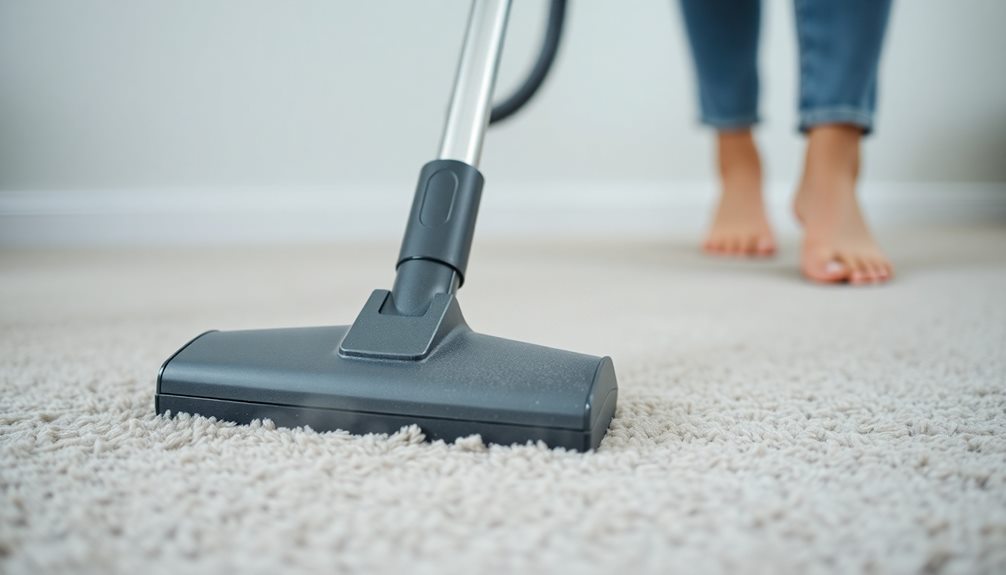
When you vacuum, moving slowly is key to picking up all the dirt and dust effectively.
Use a systematic approach by vacuuming in straight lines and overlapping your paths to guarantee complete coverage.
Don't forget to change directions and focus on high-traffic areas for a thorough clean.
Importance of Slow Movement
Taking your time while vacuuming is essential for achieving a thorough clean. By practicing slow movement when using a vacuum cleaner, you allow your device to reach its maximum dirt absorption potential. Quick movements might seem efficient, but they often miss small particles and debris that can build up over time.
Here are some key benefits of slow vacuuming:
- Enhanced Dirt Capture: Moving back and forth slowly helps the vacuum absorb dirt and dust more effectively, especially in high-traffic areas.
- Deep Cleaning: Spending extra time on each section improves cleaning results, particularly on carpets and rugs where dirt can hide.
- Optimal Suction Efficiency: Studies show that slow vacuuming increases suction efficiency, allowing the motor to operate at its best.
When you take a deliberate approach to vacuuming, you guarantee that even the tiniest particles don't escape.
Systematic movements in different directions can also help uncover hidden debris, leading to a cleaner, healthier home.
Techniques for Thorough Cleaning
To achieve a truly deep clean, vacuuming the area slowly is key. Moving your vacuum cleaner back and forth at about 1-2 inches per second allows it to absorb dirt and dust more effectively, maximizing your cleaning efficiency.
Remember the dos and don'ts: do follow a systematic grid pattern to cover every inch, ensuring no spots are missed. Don't rush through the process; taking your time pays off in the long run.
Change directions frequently, especially in high-traffic areas, to capture dirt that settles in various angles. Revisiting these spots is essential, as they tend to accumulate more dirt and require additional attention.
Pay Attention to Corners and Edges
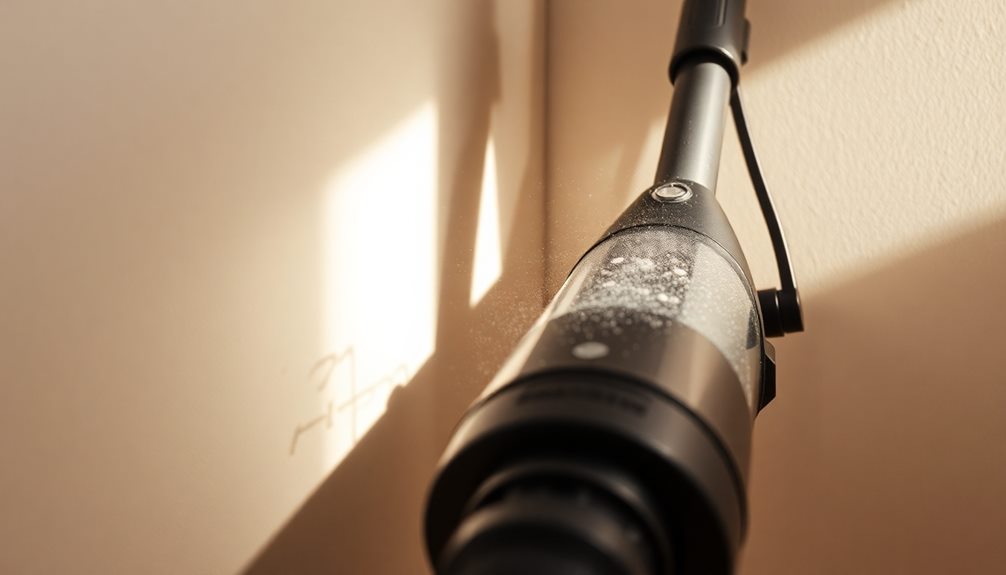
Attention to detail is essential when vacuuming, especially in corners and edges where dust and debris tend to accumulate. By focusing on these areas, you can guarantee a thorough clean and maintain a healthier environment.
Use a flat nozzle attachment with your vacuum cleaner properly to reach those tight spots effectively. Here are some tips to help you tackle corners and edges:
- Adjust the vacuum height based on your floor type for better suction.
- Move along edges in a slow, deliberate manner to capture all dirt and dust.
- Regularly vacuum high-traffic areas to prevent dust buildup.
Make it a habit to focus on corners and edges during your cleaning routine. These spots often trap allergens that can affect your health.
By dedicating extra time to these areas, you'll not only improve the appearance of your space but also reduce the risk of allergies and respiratory issues.
Complete the Vacuuming Process

After you've finished vacuuming, it's important to complete the process properly to maintain your vacuum's performance and hygiene.
Start by emptying the dust container. This step is vital to guarantee peak suction and prevent overflow, ideally done after each use. Handle the dust container carefully to minimize mess and guarantee hygienic disposal of the collected dirt and debris.
Next, clean the filters according to the manufacturer's guidelines. Regularly cleaning the filters can greatly improve your vacuuming efficiency for future sessions. Neglecting this step can lead to reduced performance and increased strain on your machine.
Don't forget about regular maintenance. Check for clogs in the hose and clean the brush rollers to prevent any buildup that could affect performance. Keeping these components in check will extend the lifespan of your vacuum cleaner and enhance its overall effectiveness.
Lastly, store your vacuum cleaner and its attachments in a designated area. This keeps them organized and easily accessible for your next cleaning session.
Dos and Don'ts of Vacuuming

Vacuuming effectively requires knowing what to do and what to avoid. By following these dos and don'ts, you can maintain your vacuum's performance and guarantee a cleaner home.
- Do regularly clean filters to maintain peak suction and performance.
- Don't vacuum large items that could clog the vacuum.
- Do remove hair and fibers from brush rollers after each use.
Cleaning your filters is essential, as clogged filters can lead to a significant decrease in your vacuum's efficiency.
Always use the appropriate nozzles for different surfaces to achieve the best results while protecting your flooring.
After each use, make it a habit to check and remove any hair or fibers from the brush rollers, since buildup can hinder performance and even cause damage over time.
On the other hand, avoid vacuuming large items, as they can lead to costly repairs.
If you notice unusual sounds coming from your vacuum, don't attempt self-repairs. This could indicate a serious issue that requires professional assistance.
Frequently Asked Questions
How to Use a Vacuum Cleaner Step by Step?
To use a vacuum cleaner step by step, start by dusting surfaces, preparing your machine, adjusting settings for different surfaces, vacuuming systematically, and finally, emptying the dust container and cleaning filters for ideal performance.
How to Use Brush Attachment on Vacuum Cleaner?
Using the brush attachment's like wielding a magic wand; it effortlessly banishes pet hair and dust. Adjust the height, move slowly, and clean the attachment regularly for a fresh, allergen-free environment you'll love.
What Is the Correct Way to Vacuum?
To vacuum correctly, start by dusting furniture and clearing the area. Adjust your vacuum settings, move slowly in overlapping paths, and revisit high-traffic spots. Finally, empty the dust container and store everything properly.
How Do You Use a Vacuum Cleaner on a Couch?
To vacuum a couch, start by removing cushions for better access. Use an upholstery attachment, adjust suction for delicate fabrics, and vacuum systematically from top to bottom, ensuring you capture all dirt and debris effectively.
Conclusion
Now that you've mastered the art of vacuuming, you're ready to tackle dust bunnies like a knight fighting dragons in the Middle Ages! Remember to keep your vacuum cleaner in good shape and adjust settings as needed for different surfaces. With a little practice, you'll make your home sparkle like a freshly polished suit of armor. So grab your trusty vacuum, and keep your living space clean and inviting for all who enter!
